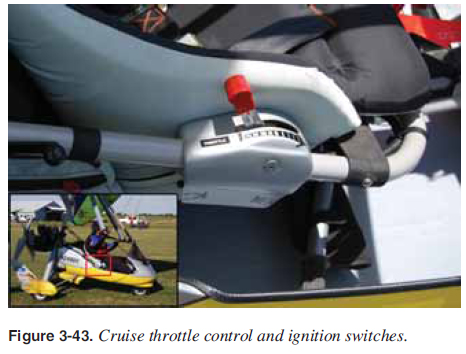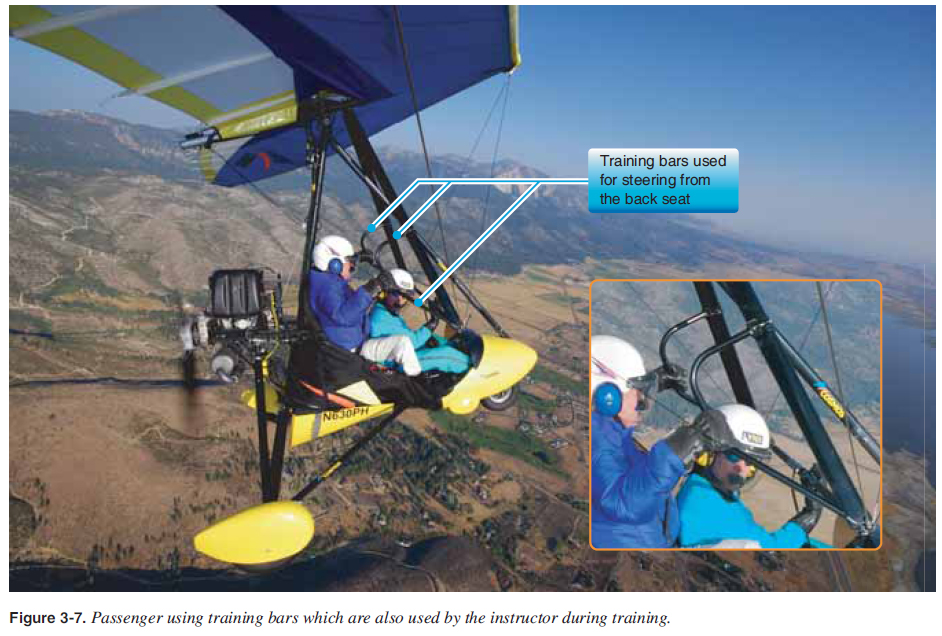
 |
|
||
| CHAPTER 3. Components and Systems
Flight Deck The fl ight deck is where the pilot and passenger sit. It is typically a tandem seating with the pilot in front and the passenger in back. When the WSC aircraft is used for instruction, the instructor typically sits in back and must have access to the fl ight controls. The pilot in the front has ground and fl ight controls. The right foot controls a foot throttle and the left foot controls the brake. This is similar to throttle and brake controls on an automobile. The feet also control ground steering by moving the front fork with the foot pedals. A foot throttle and foot brake can be added to optional ground steering control for use by an instructor sitting in back. A hand cruise throttle is typically used when the pilot can set it and it stays set. This cruise throttle is usually in a position where the instructor in the back seat can also operate it. [Figures 3-43]  The wing fl ight control bar is in a position at chest height for the pilot in the front seat. Additional extensions are added for a passenger or instructor to use if seated in the back seat. [Figure 3-7]  Ignition switches are sometimes included in the cruise control throttle housing or as a separate set of switches. If a WSC is used for instruction, the ignition switches should be within reach of the instructor sitting in the back seat. [Figures 3-43] The ballistic parachute handle must be accessible for use when needed but not put in a position where it could be accidentally deployed. Some WSC aircraft have two handles, one for the front and one for the back. Additional controls for starting, such as the choke or enricher, must be accessible to the pilot. Dashboards and Instrument Panels The instrument panel is in front of the pilot and provides engine, fl ight, navigation, and communications information. The pilot is responsible for maintaining collision avoidance with a proper and continuous visual scan around the aircraft, as well as monitoring the information available from the instrument panel. The pilot must process the outside cues along with the instrumentation throughout the fl ight for a sound decision-making process. The ignition switches, which may be located on the instrument panel or within the instructors reach for WSC used for instruction, has two positions: ON, which allows power to make contact with the spark plugs, or OFF, which is a closed switch to GROUND and removes the power source from the spark plugs. Typically, WSC engines have two spark plugs per cylinder, two switches, and two completely separate ignition systems. Some single-place WSCs with smaller engines have only one spark plug per cylinder, one ignition switch, and a single ignition system. For example, for a two-stroke liquid-cooled engine, the manufacturer may require instrumentation to monitor engine exhaust gas temperatures (EGT), water temperatures, and revolutions per minute (rpm). Additionally, for a fourstroke engine, the manufacturer may additionally require oil temperature and pressure gauges. For a simple two-stroke aircooled engine, the manufacturer’s requirement may be EGT, cylinder head temperature (CHT) and rpm instrumentation. Generally, most electrical or engine controls are located on the dashboard unless required to be reached by the instructor for fl ight instruction. Dashboards are as varied as the manufacturers and the purpose of the aircraft, from simple to complex. Classical analog gauges are common, but digital instruments are becoming more popular with light-sport aircraft (LSA). Overall, no instrumentation is required for E-LSA, but for S-LSA an airspeed indicator is usually required, and engine manufacturers require certain instruments be installed on the aircraft to monitor the performance of the particular engine. |
| ©AvStop Online Magazine Contact Us Return To Books |